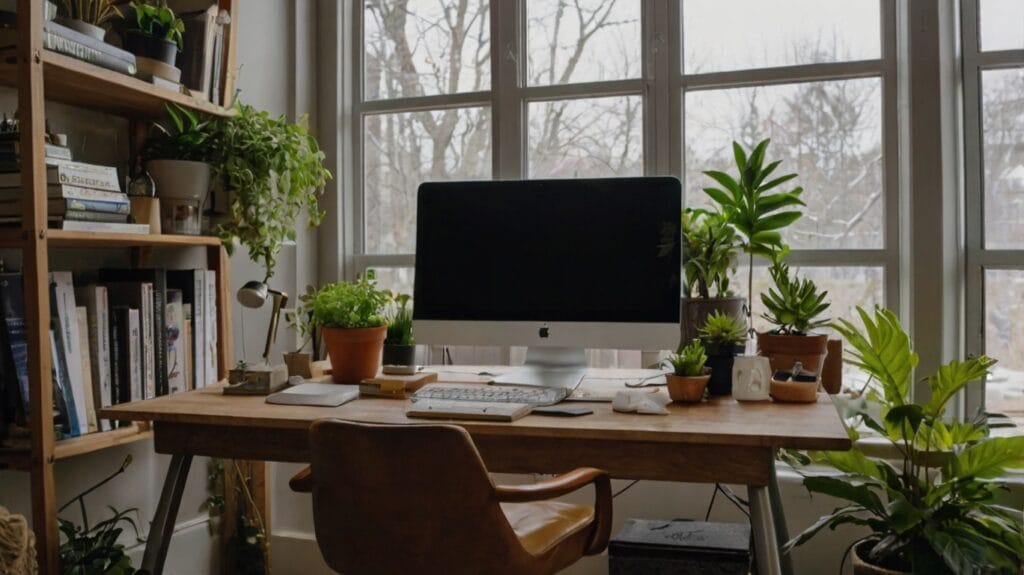In recent times, remote work has skyrocketed, ushering in a new era of flexibility and independence for professionals worldwide. For small business owners, marketers, and tech enthusiasts, an optimized home workspace is more critical than ever. It’s not just about having a place to work; it’s about creating an environment that boosts productivity and fuels creativity. In this blog post, we’ll explore how to create a home workspace that not only meets but exceeds your productivity expectations.

Understanding Your Workspace Needs
Before embarking on the transformation of your home workspace, it’s crucial to understand what you truly need to be productive. This isn’t a one-size-fits-all scenario. Each profession, and each individual, has unique requirements. Let’s dig into a few key factors you need to consider.
Ergonomics and Comfort
Comfort is the foundation of a productive workspace. Ergonomics plays a vital role in preventing physical discomfort, which can hinder focus. Ensure your chair supports your spine, your desk is at the right height, and your monitor is positioned at eye level. A footrest can also help maintain a comfortable posture. It’s not just about comfort, but about creating a space where your body can work efficiently without strain.
Technology and Connectivity
In today’s digital age, technology is the backbone of any successful workspace. Fast and reliable internet connectivity is non-negotiable. Consider investing in a high-speed router or a mesh network system for seamless connectivity. Additionally, ensure all your devices are up-to-date and capable of handling the demands of your work tasks. This will help you avoid frustrating disruptions and keep your workflows smooth.
Organization and Personalization
A cluttered workspace often leads to a cluttered mind. Organization is key. Use shelves, cabinets, or storage boxes to keep your workspace tidy. But don’t forget to add a personal touch. Incorporate personal items like photos, plants, or art that inspire you. Personalizing your workspace can make it more welcoming and enjoyable, which can enhance your overall productivity and work satisfaction.
Designing Your Home Workspace for Success
Designing your home workspace involves more than just placing a desk in a quiet corner. It requires careful planning and thoughtful choices to maximize its potential.
Choosing the Right Space
The first step is choosing the right location. If possible, select a room or area with natural light. Natural light not only boosts your mood but also reduces eye strain. If a separate room isn’t available, consider using room dividers or curtains to create a distinct workspace. Ensure the space is free from distractions and allows for some privacy during work hours.
Furniture and Equipment Selection
Selecting the right furniture and equipment is essential. Invest in a sturdy desk and a comfortable chair. Adjustable standing desks can offer versatility, allowing you to alternate between sitting and standing. Additionally, consider the equipment you’ll need, such as a computer, printer, and additional monitors. Prioritize quality and functionality to create an efficient and pleasant workspace.
Tips for Space Optimization
Space optimization is about making the most of what you have. If you’re working with limited space, consider wall-mounted desks or foldable furniture. Vertical storage solutions can help maximize floor space. Use cable management tools to keep cords organized and out of the way. A well-organized workspace can enhance your focus and productivity.

Enhancing Productivity with Technology
Technology can be a game-changer in your home workspace. Let’s explore how you can leverage it to boost your productivity.
Essential Tools and Software for Remote Work
Invest in tools and software that streamline your work processes. Project management tools like Trello or Asana can help you stay organized and manage tasks efficiently. Communication platforms like Slack or Zoom facilitate seamless collaboration with team members. Additionally, consider cloud storage solutions like Google Drive or Dropbox for easy access to files from anywhere.
Connectivity and Security Considerations
Secure and reliable connectivity is paramount for remote work. Ensure your Wi-Fi network is password-protected and consider using a VPN for secure browsing. Regularly update your software and hardware to protect against cyber threats. Cybersecurity is a growing concern, and taking proactive measures can safeguard your work and data.
Tech Gadgets that Can Improve Efficiency
Tech gadgets can add convenience and efficiency to your workspace. Noise-canceling headphones can help you concentrate in a noisy environment. A smart speaker or assistant can set reminders and control smart devices with voice commands. Additionally, consider investing in a second monitor for multitasking, which can significantly boost productivity.
Tips for Maintaining Work-Life Balance in a Home Workspace
Maintaining work-life balance is crucial when working from home. Here are some tips to help you achieve it.
Establishing Boundaries
Set clear boundaries between work and personal life. Designate specific work hours and stick to them. Communicate your schedule with family members or roommates to minimize interruptions. When work hours are over, disconnect and focus on personal time. Establishing boundaries helps prevent burnout and promotes mental well-being.
Scheduling and Time Management
Effective scheduling and time management are key to productivity. Use digital calendars or time management tools to plan your day. Prioritize tasks and allocate time for breaks to recharge. Pomodoro Technique, which involves working in focused intervals followed by short breaks, can enhance concentration and productivity.
The Importance of Mental Health in Remote Work
Remote work can blur the lines between personal and professional life, affecting mental health. Take breaks to stretch or go for a walk. Practice mindfulness or meditation to reduce stress. Stay connected with colleagues and social circles through virtual coffee breaks or video calls. Prioritizing mental health is essential for long-term productivity and well-being.
Real-Life Examples Showcasing Effective Home Workspaces
Let’s take inspiration from real-life examples of effective home workspaces. These success stories can provide valuable insights and ideas for your own setup.
Entrepreneur Sarah transformed her spare bedroom into a productive workspace by using a standing desk and adding wall-mounted shelves for storage. She personalized the space with artwork and plants, creating a calming and inspiring environment.
Marketer Alex converted a corner of his living room into a functional workspace by utilizing a foldable desk and a pull-out drawer for office supplies. He maximized lighting with adjustable LED desk lamps, ensuring a well-lit and comfortable area for creative tasks.
Tech enthusiast Lisa set up her workspace in a cozy nook by the window. She invested in a high-quality ergonomic chair and dual monitors for multitasking. Her use of cable organizers kept the space tidy and organized, enhancing focus and productivity.
Conclusion The Future of Remote Work and the Impact of a Well-Designed Home Workspace
The future of work is increasingly digital, and a well-designed home workspace is a pivotal component of this transformation. By understanding your workspace needs, optimizing design and technology, and maintaining work-life balance, you can unlock your full productivity potential.
A thoughtfully crafted home workspace can elevate your work experience, foster creativity, and enhance overall well-being. Whether you’re a small business owner, marketer, or tech enthusiast, investing time and effort into creating an ideal workspace is a decision that pays dividends.
Call to Action Encouraging Readers to Share Their Workspace Tips and Experiences
We’d love to hear from you! Share your workspace tips and experiences in the comments below. How have you optimized your home workspace to boost productivity? Join the conversation and inspire others to create their ideal work environment.




Leave a Reply